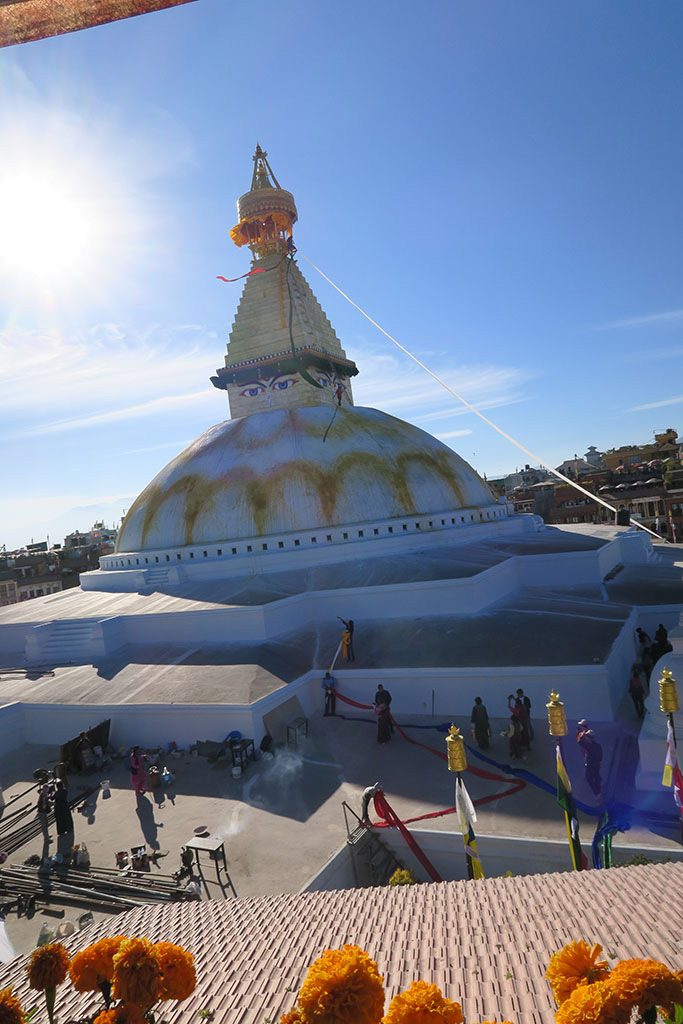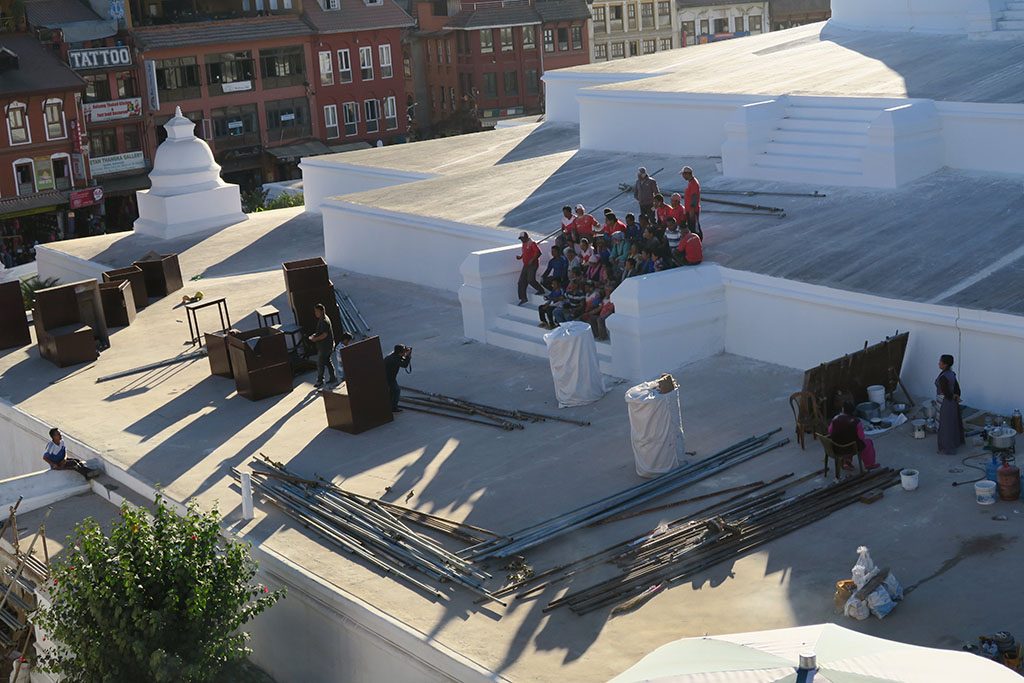It’s spelled Kathmandu, with an “h.” And actually we’re leaving tomorrow for Bhutan.
Our stay in Nepal has been a barrage of impressions for me, and I think a jarring experience for Mary. She’s been talking about how she loves Nepal: the simplicity of life, its laid-back atmosphere, friendly people that live in a traditional style. She was sort of dreading parts of the trip, particularly going to Kathmandu.
What hits you immediately is the traffic and the foul air. You see the haze before you land. No, it wasn’t just low-hanging clouds (I’m an eternal optimist.) According to Hari, our guide, the traffic and the population explosion in Kathmandu is due to a number of things, but the most prominent is that at one point there was a Communist rebel group that was behaving like ISIS in the countryside, and that drove a huge number of people into the city. That may be true, but I suspect there was also a good deal of “How you gonna keep them on the farm once they’ve seen (insert city name here).”
The second shock is one we’ve prepared for, the devastation wrought by last year’s earthquake. It’s everywhere: buildings that have been turned into piles of rubble, temples that are no longer there, a hustle to rebuild. This latter adds to the air pollution: much of that is just dust from the construction.
In terms of the traffic, it has been incredibly stressful sitting in the back of the van our tour company hired for us. Let me put it this way: even if you’re in the back seat, seeing an 18-wheeler heading straight for you, on your side of the road, is disconcerting. The driver is very skillful, and there was never a mishap, but the roads are always overcrowded, with small vehicles, motorbikes and scooters darting around in death-defying ways. I can’t discern any rules beyond you sort of stay to the left; most traffic comes toward you on the right; and (number 1) the “stronger” vehicle gets the right of way. Oh, and since pedestrians are the least “strong” they’re on their own.
Yes, we saw some people, particularly old ones, wearing traditional costumes and praying at the various temples, but there is a preponderance of hip youngsters riding their scooters dressed in black and sporting modern, urban-style haircuts. Everyone was driving crazy, chatting on smartphones, selling all manner of junk, much of it more expensively than we can get it at home, almost none of it unique or representative of Nepal.
I’m going to keep this short, because today was long, and tomorrow we head for Bhutan. I want to talk to you about my reactions in detail, and include some drawings or paintings, but that will have to wait. In brief, our first evening there, we visited the large Buddha Stupa that is near our hotel. We had a rooftop meal there, at the Paradise Restaurant, while some of the locals were enjoying an outdoor movie in the courtyard. I couldn’t tell if it was Bollywood or Kollywood (“K” for Kathmandu, get it?).
The next day we took a tour of Patan, a district of Kathmandu that has a lot of history and beautiful architecture, and an area that specializes in woodcarving. As part of this excursion we also visited a Tibetan refugee camp, where they make wool carpets. More on that another time.
Today we went to Dhulikel, which has a great view of the Himalayas, and is supposed to be a much more traditional village. Then on to Bhaktapur, Mary’s favorite town, which is nearer Kathmandu (about 30km). Walking around Bhaktapur triggered a lot of dear memories in Mary. We ate lunch in a restaurant that she really liked when she was there many years ago. She was surprised and delighted that it was unhurt by the earthquake. And while many of the town’s landmarks were flattened, some had already been rebuilt, which was heartening.
Against her wishes, I insisted we also visit downtown Kathmandu. This was hard for her, as many of the farm-lined country lanes she remembers are now nasty, dusty, hectic 4-lane roads, carrying 8 lanes of traffic, and lined with housing developments and businesses. We did, though find some of her old haunts, and that made her happy. The Pumpernickel coffee shop, which was her touchpoint in those days, is still there, though much more modern looking, and the old wooden column in the middle of the entrance, to which they would nail Mary’s incoming mail, is no longer there.
I’ll leave you with one image: Yesterday, when we returned to the Paradise Restaurant for lunch, a large group of volunteers had just removed the scaffolding that supported the rebuilding of the Buddha Stupa, and were finishing repainting it. As we were finishing our meal, they were celebrating and having their pictures taken:


Next stop: Bhutan
